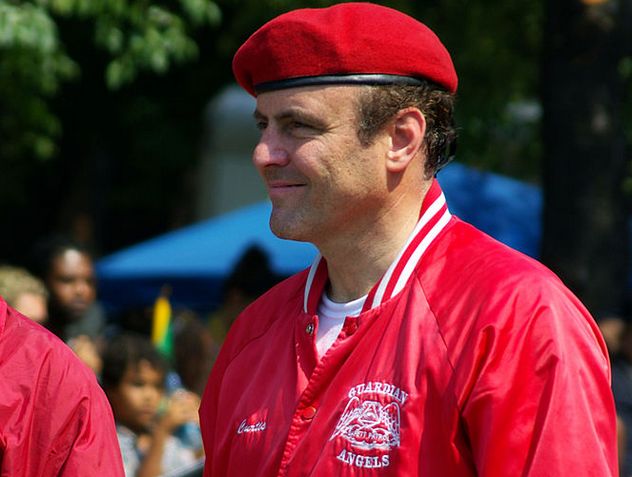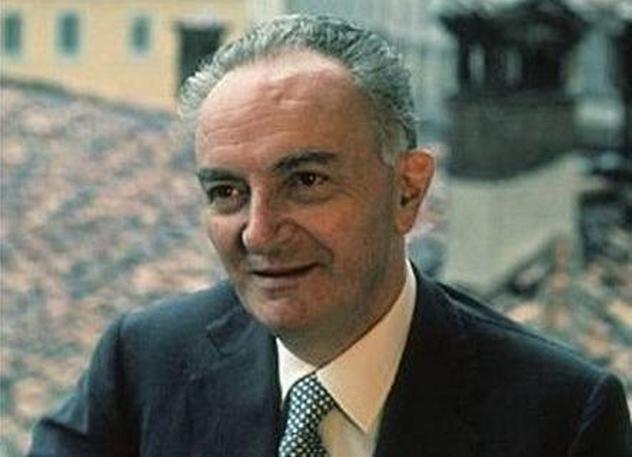 Technology
Technology  Technology
Technology  Humans
Humans 10 Everyday Human Behaviors That Are Actually Survival Instincts
 Animals
Animals 10 Animals That Humiliated and Harmed Historical Leaders
 History
History 10 Most Influential Protests in Modern History
 Creepy
Creepy 10 More Representations of Death from Myth, Legend, and Folktale
 Technology
Technology 10 Scientific Breakthroughs of 2025 That’ll Change Everything
 Our World
Our World 10 Ways Icelandic Culture Makes Other Countries Look Boring
 Misconceptions
Misconceptions 10 Common Misconceptions About the Victorian Era
 Mysteries
Mysteries 10 Strange Unexplained Mysteries of 2025
 Miscellaneous
Miscellaneous 10 of History’s Most Bell-Ringing Finishing Moves
 Technology
Technology Top 10 Everyday Tech Buzzwords That Hide a Darker Past
 Humans
Humans 10 Everyday Human Behaviors That Are Actually Survival Instincts
 Animals
Animals 10 Animals That Humiliated and Harmed Historical Leaders
Who's Behind Listverse?

Jamie Frater
Head Editor
Jamie founded Listverse due to an insatiable desire to share fascinating, obscure, and bizarre facts. He has been a guest speaker on numerous national radio and television stations and is a five time published author.
More About Us History
History 10 Most Influential Protests in Modern History
 Creepy
Creepy 10 More Representations of Death from Myth, Legend, and Folktale
 Technology
Technology 10 Scientific Breakthroughs of 2025 That’ll Change Everything
 Our World
Our World 10 Ways Icelandic Culture Makes Other Countries Look Boring
 Misconceptions
Misconceptions 10 Common Misconceptions About the Victorian Era
 Mysteries
Mysteries 10 Strange Unexplained Mysteries of 2025
 Miscellaneous
Miscellaneous 10 of History’s Most Bell-Ringing Finishing Moves
10 Outrageous Kidnapping Hoaxes
One crime that is virtually guaranteed to garner attention from the media is kidnapping. Whenever someone is abducted and held against their will, often for the purposes of a ransom demand, the world waits with anticipation to find out if the victim will be returned safely. If the victim manages to survive the ordeal, there is anticipation about whether the perpetrators will be brought to justice.
However, the anticipation suddenly turns to anger if it is discovered that there was no actual kidnapping and the entire incident was nothing more than an elaborate hoax. Whether it be for monetary gain, publicity, or attention, some people have actually gone to the trouble of fabricating phony kidnapping stories that fooled the world.
10John Factor

During the Prohibition era of the 1920s and 1930s, gangster Roger Touhy ran a very successful bootlegging operation in Chicago. However, he wound up becoming rivals with Al Capone, who wanted to take over Touhy’s operation. The two sides went to war, but instead of simply killing Touhy, Capone decided to take the unusual step of framing his rival for a crime he did not commit. In 1933, a corrupt investigator on Capone’s payroll falsely accused Touhy and his gang of being responsible for the kidnapping of a brewery heir named William A. Hamm. They were subsequently indicted. However, the actual perpetrators of the crime were members of another gang, so Touhy and his associates were acquitted at the trial. Nevertheless, Capone was successful at getting Touhy convicted of another kidnapping.
Instead of trying to pin someone else’s crime on Touhy, Capone fabricated an elaborate setup to frame him for the non-existent kidnapping of a gangster/con artist named John Factor, aka “Jake the Barber.” Factor told the police that he had been kidnapped by Touhy and his gang, who released him after his wife paid a $70,000 ransom. Even though there was no evidence that Touhy committed this crime, Factor and several other witnesses provided lots of perjured testimony against Touhy at his trial. In February 1934, Touhy and three of his associates were found guilty and given 99-year sentences. Aside from an unsuccessful escape attempt in 1942, Touhy remained wrongfully incarcerated for 25 years. His sentence was eventually commuted, and he managed to get parole in December 1959. Less than a month after his release, Touhy was gunned down in a mob hit.
9Nicole Riche

On March 29, 1950, a 22-year-old actress named Nicole Riche was performing in a play at the Grand Guignol Theater in Paris—a venue that was known for staging violent and bloody horror productions. At some point during the performance, Riche received a note signed by a “Richard Masso,” urgently requesting to speak with her about her mother. She exited the theater but never returned, and the rest of the performance had to be canceled. Since Riche happened to be performing in a production about a woman who was kidnapped, this unusual event made headlines. Nicole Riche was not seen for two days, until she suddenly walked into a Paris police station. Appropriately enough, it was the early morning hours of April Fools’ Day.
Riche claimed that she had been kidnapped and held against her will by Puritans, who chastised her for her immoral lifestyle. After two days of captivity, Riche’s kidnappers decided to leave her in the forest of Fontainebleau, where some gypsies eventually helped her back to the city. The police were immediately skeptical of Riche’s story, because even though she supposedly went through a traumatic ordeal and had been wandering through the forest, there did not seem to be a hair out of place on her. After more questioning, Riche finally confessed that her “kidnapping” was nothing more than a publicity stunt dreamed up by the Grand Guignol Theater manager, Alexandre Dundas. In a disturbing turn of events, a male actor from Riche’s show had attempted to commit suicide shortly after her fabricated disappearance, supposedly because he was in love with her.
8Wassef Ali Hassoun

Throughout the past decade, a number of American soldiers have been kidnapped and murdered by terrorist groups while serving in Iraq. However, a Lebanese-American soldier named Wassef Ali Hassoun took the unusual step of fabricating his own kidnapping in order to desert his post. In 2004, Hassoun was a corporal in the United States Marine Corps. He was stationed at a base near the city of Fallujah. On June 20, Hassoun went missing. One week later, the Al Jazeera news network broadcast a photograph of a blindfolded Hassoun who was being held captive with a sword over his head. It was accompanied by a message stating that Hassoun had been kidnapped by a group called “National Islamic Resistance,” who were planning to hold him hostage until certain detainees were released from prison.
Over the course of the next week, rumors started circulating that Hassoun had been beheaded. However, on July 8, unharmed Hassoun suddenly showed up at the US Embassy in Beirut. Five months later, after an extensive investigation, the Marines would announce that Hassoun had actually deserted his post and that his entire kidnapping was a hoax. Hassoun was charged with desertion and theft of government property. He faced potential prison sentences of 5 to 10 years for each offense. At the time, Hassoun was serving at Camp Lejeune in North Carolina. In January 2005, he failed to report back from his leave and has not been seen since. The circumstances of how Hassoun fabricated his own kidnapping remain unclear, but he remains a wanted fugitive in the United States. He is believed to be living in Lebanon.
7Tawana Brawley
On November 24, 1987, Tawana Brawley—a 15-year-old African-American girl from Wappingers Falls, New York—paved the way for an eventual media circus when she disappeared without explanation. Four days later, Brawley was found inside a trash bag near an apartment building. She was smeared with feces, her clothing was torn, and racial slurs were scrawled on her body. After being taken to the hospital, Brawley claimed that she had been kidnapped and repeatedly raped in a wooded area by three white men. Brawley would later accuse Dutchess County Assistant District Attorney Steven Pagones of being one of the assailants. The case became the subject of national outrage. Brawley was soon represented by a trio of civil rights activists, including Reverend Al Sharpton, who accused several high-ranking state officials of covering up the crime.
However, upon review of the evidence, a grand jury eventually determined that there were numerous inconsistencies in Brawley’s story and that the entire incident had been fabricated. Brawley was never kidnapped or sexually assaulted. She staged the crime in order to avoid being punished by her violent stepfather for skipping school. Forensic evidence showed no signs of sexual abuse or any indication that she had been held in the woods for days. Schoolmates testified to seeing Brawley at a party during the time of her alleged attack. One witness even claimed to have seen her climbing into the trash bag herself. Steven Pagones was completely exonerated of all charges and would file a lawsuit for defamation of character against Sharpton, Brawley, and her attorneys. Even though Pagones was awarded a judgment in 1998, Brawley would not start paying restitution to him until 2013.
6Flint Rhem

Flint Rhem was a starting pitcher for the St. Louis Cardinals, a team that was in the heat of the 1930 National League pennant race as the season neared its end. They traveled to Brooklyn for an important three-game series against the rival Robins, who were competing with the Cardinals for first place. Rhem was slated to pitch the second game in the series on September 19, but he mysteriously disappeared from the Alamac Hotel and missed his scheduled start. Rhem was not seen again for two days, until he suddenly reappeared at the hotel, reeking of alcohol. When asked where he had been the whole time, Rhem initially dodged the question, until a reporter made a wisecrack about Rhem being kidnapped. The pitcher then surprised everyone by claiming that that was exactly what happened.
According to Rhem, he was kidnapped at gunpoint by gangsters and taken to a log cabin in the woods. The gangsters forced him to consume a bunch of liquor, because they had gambling interests in the Brooklyn Robins and wanted to make Rhem too drunk to pitch against them. Since Rhem was notorious for his heavy drinking, many people were skeptical about this alleged “kidnapping,” but Cardinals general manager Branch Rickey said: “You couldn’t disprove his story by the way he smelled.” No evidence was ever found to back up Rhem’s story, but since his absence did not affect the team and the Cardinals wound up winning the pennant anyway, his shenanigans went unpunished. In actuality, Rhem had spent his missing two days with friends on a massive bender at a local gin joint. He did not come clean about it until a team reunion 21 years later.
5Shannon Matthews
On February 19, 2008, a nine-year-old girl named Shannon Matthews went missing after leaving her school in Dewsbury, England. A massive search was conducted for Shannon. It was feared that she may have been kidnapped and murdered. When no trace of Shannon was found for weeks, a £50,000 reward was eventually offered for her safe return. Thankfully, Shannon would be found alive on March 14, in the nearby district of Batley Carr. She was discovered inside a flat that belonged to a man named Michael Donovan. However, Shannon’s recovery would soon spark a massive outrage once it was revealed that her “kidnapping” was a hoax fabricated by her own mother, Karen Matthews.
Michael Donovan just happened to be the uncle of Karen Matthews’s boyfriend. Shannon had been taken by Michael and held captive at his flat during the 24 days she was missing. She was drugged and kept hidden inside a divan bed. Shortly after his arrest, Michael told authorities that Karen had orchestrated her daughter’s phony abduction, hoping to cash in on the inevitable publicity. The eventual plan was for Michael to pretend to “find” the missing Shannon at a different location. Then he would turn her in to claim the £50,000 reward, which he would subsequently split with Karen. In December, Karen and Michael were sentenced to eight years in prison for their crimes, but have since gotten an early release.
4Curtis Sliwa

It’s rare to find an example of a real kidnapping that exposes a prior fake kidnapping, but that’s exactly what happened to controversial anti-crime activist Curtis Sliwa. In the late 1970s, Sliwa formed an organization called the “Guardian Angels,” a group of volunteer citizens who patrolled New York City to combat its high crime rate. Needless to say, police officials did not appreciate the Guardian Angels attempting to do their jobs for them, and the organization allegedly became the target of threats and harassment. On October 20, 1980, Sliwa made front-page news after claiming he had been kidnapped by a trio of New York City Transit Police officers who threatened to kill him if the Guardian Angels did not stop patrolling the subways.
On June 19, 1992, Sliwa would survive a serious threat on his life after he was picked up by a taxi. The taxi had been stolen by two armed men who proceeded to kidnap Sliwa and shoot him twice. He managed to escape by leaping out the window. While recovering from his wounds, Sliwa made a stunning confession. Even though this particular kidnapping attempt was real, Sliwa admitted that the kidnapping incident from 1980 was a complete hoax.
In fact, Sliwa also confessed that the Guardian Angels had staged a total of six hoaxes during their early years, in order to garner publicity for the organization. In addition to fabricated threats, Sliwa also had the Angels pretend to stop some phony staged muggings to give off the appearance that they were successfully thwarting crimes. Naturally, this revelation did not go over well with some people. Sliwa was hit with a libel lawsuit from the Transit Authority’s Police Benevolent Association.
3Michelle Lodzinski

In 1991, Michelle Lodzinski, a 23-year-old single mother from South Amboy, New Jersey, found herself at the center of controversy. Her five-year-old son, Timothy Wiltsey, went missing. Michelle claimed that Timothy disappeared while they were attending a carnival in Sayreville on May 25. However, there were numerous inconsistencies in her constantly changing story, and no other witnesses could recall seeing Timothy at the carnival that night. On April 23, 1992, Timothy’s skeletal remains were found in a marshy area at an industrial park in Edison, but his cause of death could not be determined. Even though Michelle was a suspect, there was not enough evidence to charge her with anything. Michelle’s story got even weirder two years later, when she decided to fabricate her own kidnapping.
On January 21, 1994, Michelle mysteriously disappeared and turned up in Detroit the following day. Michelle claimed that she had been kidnapped at gunpoint by FBI agents outside her apartment. The abduction was allegedly motivated by an investigation into a former police officer who had been harassing Michelle. These FBI agents supposedly drove her to Detroit before letting her go. An FBI business card was also found taped to the door of Michelle’s apartment. It read: “SEE YOU SOON its not over.”
However, Michelle finally confessed that the whole incident was a hoax once it was discovered that she had printed some fake FBI business cards and taken a bus to Detroit. She would be sentenced to six months house arrest. Two decades later, Michelle Lodzinski is still the prime suspect in Timothy Wiltsey’s death, but the case remains unsolved.
2Michele Sindona

During the 1970s, Michele Sindona was the most powerful financial figure in Italy. He owned several banks, which he used as a front to launder money for the Sicilian mafia. Sindona also had a controlling interest in Franklin National Bank in Long Island, but he would defraud them of $45 million. After the bank collapsed in 1974, Sindona was indicted on 99 counts of bank fraud. On July 11, 1979, he was suspected of ordering the assassination of Giorgio Ambrosoli, an Italian lawyer who was providing American authorities with evidence against Sindona. At the time, Sindona was free on a $3 million bond. He was scheduled to stand trial in New York City in September, but he came up with an unexpected way to delay the proceedings.
On August 2, Sindona mysteriously disappeared. Shortly afterward, word spread that he had been kidnapped by an organization known as the “Proletarian Committee of Subversion for Better Justice.” Sindona’s lawyers would soon receive a photo of him holding a sign that read: “The fair trial will be done by us.” Sindona was not seen again until October 16, when he appeared at a New York hospital with a gunshot wound to his leg. He claimed he had convinced his kidnappers to let him go.
In actuality, Sindona had gotten some of his mafia associates to fabricate his abduction. He spent over two months hiding out in Sicily, attempting to blackmail political figures into bailing out his banks. Sindona even had himself shot in the thigh to make his story look more convincing. However, the kidnapping was dismissed as a hoax, and Sindona would be sent to prison on charges of fraud and for orchestrating Ambrosoli’s murder. In 1986, he was poisoned after drinking cyanide-laced coffee.
1Aimee Semple McPherson
During the 1920s, Aimee Semple McPherson was the most famous Christian evangelist in the world and a bonafide celebrity. She would eventually become the center of one of the most sensational media circuses of all time. On May 18, 1926 she went swimming at Ocean Park Beach in California. McPherson disappeared that day and was presumed to have drowned. McPherson’s mother showed up at her scheduled sermon that night to announce her daughter was missing. The country went into a frenzy. Thousands of people mourned McPherson’s presumed death. However, things took a surprising turn one month later when McPherson’s mother received a ransom note, demanding $500,000 for the release of her daughter. On June 23, McPherson shocked everyone by emerging from the desert and arriving in the Mexican border town of Agua Prieta.
McPherson claimed she had been held captive in a shack by two men and a woman, but managed to escape and make a 32-kilometer (20 mi) trek across the desert to freedom. While the public was overjoyed that McPherson was alive, investigators were very skeptical of her story—especially once it was discovered that Kenneth G. Ormistion, an engineer from McPherson’s radio station, had also disappeared at the same time. In fact, witnesses claimed to have seen McPherson and Ormiston together at a cottage during the month they were missing. Since Ormiston was married, it was speculated that McPherson staged her own disappearance in order to conduct a secret affair with him. McPherson would testify in front of a grand jury and face charges of fraud and obstruction of justice. However, the charges were eventually dropped. While the full truth behind McPherson’s disappearance may never be known, the general consensus is that the kidnapping never happened.
Robin Warder is a budding Canadian screenwriter who has used his encyclopedic movie knowledge to publish numerous articles at Cracked.com. He is also the co-owner of a pop culture website called The Back Row and recently worked on a sci-fi short film called Jet Ranger of Another Tomorrow. Feel free to contact him here.








